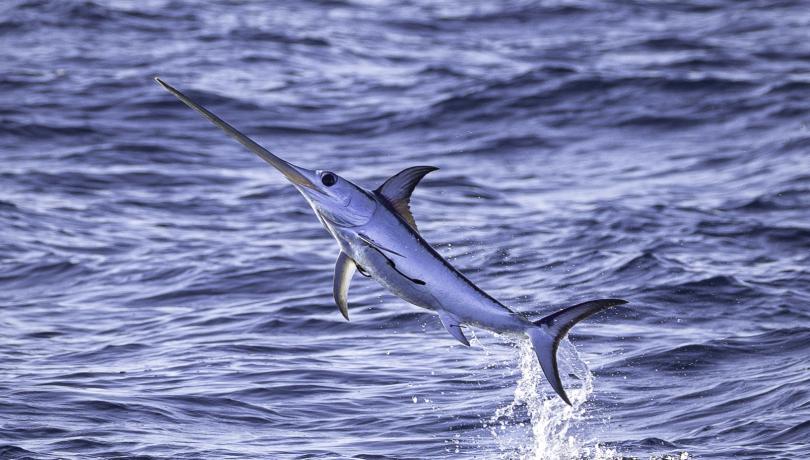Is the main conclusion of a study led by the ICM-CSIC, which reveals how environmental and human factors determine the type of food consumed by this commercially important species, providing key insights for its sustainable management.

The diet of large marine predators not only reflects the state of the ecosystems they inhabit, but can also provide insights as to how these ecosystems will respond to climate change and human activity. A recent study led by the Institut de Ciències del Mar (ICM-CSIC) and published in the Journal of Animal Ecology shows that both oceanographic conditions and fishing pressure significantly influence the feeding habits of the swordfish (Xiphias gladius), a key species in the pelagic food webs of the Mediterranean and Atlantic waters.
The research identifies spatial variations in the swordfish's diet linked to environmental conditions, such as water temperature and patterns of marine productivity, as well as to human pressures, including fishing intensity. These findings have direct implications for the conservation of this species, which is of great fishing interest, and for the design of conservation strategies adapted to future global change scenarios.
“Understanding the factors that determine the swordfish’s diet allows us to anticipate possible changes in its ecological role,” explains Elena Fernández Corredor (ICM-CSIC), lead author of the study. “This information is key to applying more integrative conservation approaches, especially in a context of strong environmental and anthropogenic pressure,” adds the researcher.
The influence of the environment and human activity
The study shows that swordfish consumption of fish increases in areas where the oceanic mixed layer is deeper. By contrast, the intake of squid is associated with both swordfish size and fishing pressure, suggesting that this activity may be altering prey availability or changing the composition of the different food resources on which swordfish feed.
On the other hand, the study identifies a greater dependence on gelatinous organisms (such as salps) in less productive regions. According to the scientific team, this trend could indicate a lower availability of prey such as fish and cephalopods in certain areas, forcing the swordfish to resort to less energy-rich alternatives.
“These results not only describe the current diet of the species, but also provide a basis for predicting how its feeding patterns may change as oceanic conditions evolve,” notes Francisco Ramírez (ICM-CSIC).
To carry out the study, the team combined advanced trophic analysis tools, such as Bayesian Stable Isotope Mixing Models, with Generalised Additive Models (GAMs) to explore the relationship between diet and environmental and anthropogenic variables. In addition, the study incorporates a prospective modelling exercise to assess how the swordfish diet might change under different climate change scenarios, constituting an innovative approach in the study of large pelagic species.
“The added value of the study lies in its ability to integrate different sources of information and project future ecological changes with greater precision,” highlights Joan Navarro (ICM-CSIC). “This makes it a highly useful tool for planning conservation policies in the medium and long term.”
Implications for conservation
The findings underline the need to consider both trophic interactions and environmental and human factors in the management of marine resources. In particular, the study highlights how changes in the swordfish’s diet can act as indicators of broader ecological imbalances, arising from global warming or excessive fishing pressure.
Finally, the use of stable isotope techniques will be promoted as a continuous monitoring tool, enabling the implementation of more efficient and large-scale monitoring systems.
According to researchers, this work represents a significant advance in the understanding of the trophic ecology of large pelagic species and reinforces the need to integrate scientific knowledge into decision-making on the conservation and sustainable use of marine resources. From this perspective, the knowledge generated can contribute to the formulation of more integrated fisheries policies, which not only regulate catch levels but also protect the functional role of species within the ecosystem.
Apart from the ICM-CSIC, the Spanish Institute of Oceanography (IEO-CSIC) has contributed to this work by providing key data from its onboard observer program on commercial vessels—a unique historical series in the Mediterranean context.
"This initiative, which has been monitoring catches and fishing activity in real time for decades, has been essential in more accurately characterizing the species’ trophic interactions and its response to fishing pressure," explains David Macías, researcher at the Oceanographic Center of Málaga and co-author of the study.